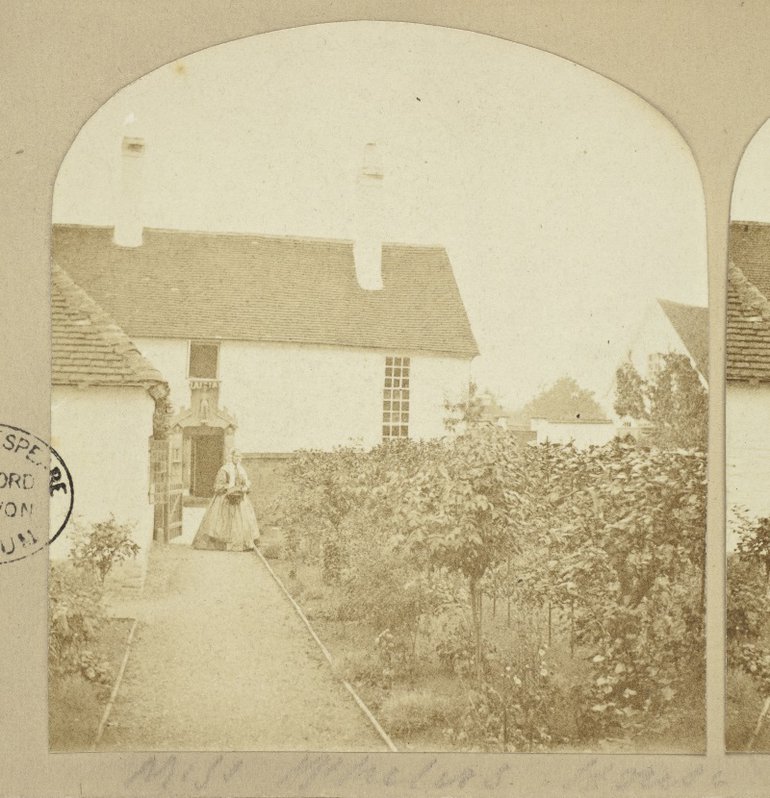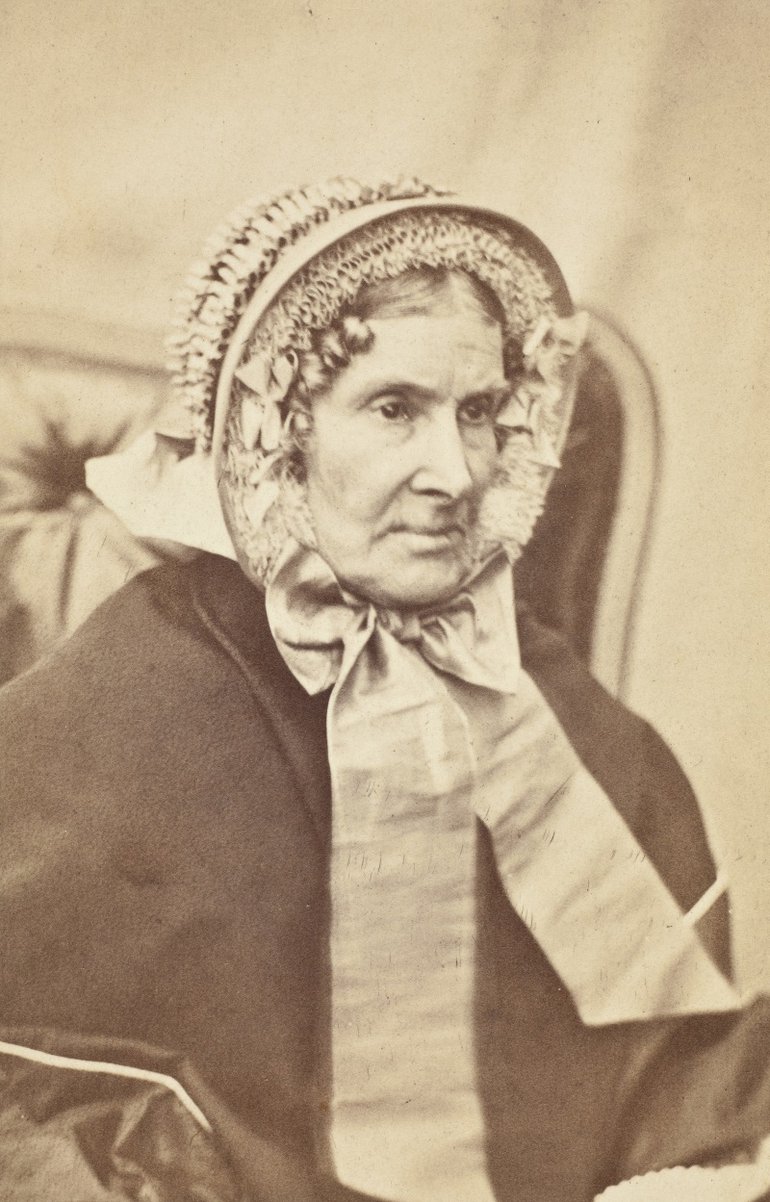
When I began my research into Anne Wheler, the mysterious benefactor of a large collection of Shakespearian items including the 3rd folio in question, it quickly became clear just how little we know of her.
Anne, who was born circa 1783, remained unmarried in life, meaning that upon their father's death, her younger brother Robert Bell Wheler became responsible for her in the eyes of the law. Anne lived together with him and their sister Elizabeth in the family home in Stratford for the duration of her life. The Whelers were an old and respected Stratfordian family, so the siblings enjoyed modest wealth and reputation within their community.
But what is their connection to Shakespeare, you may ask? Well, that connection began with Robert. Whilst working as a solicitor in Stratford, Robert's passion for Shakespeare and Stratford's rich history encouraged him to collate a large collection of antiquarian books and items associated with Shakespeare, which included a rare first folio of Shakespeare's work.
Following Robert's death in 1857, his wealth and property were bequeathed to Anne; the precious folios and antiques falling into her possession and care. Ultimately it was she who decided to generously donate this collection to the Trust in 1865, shaping the Shakespeare Birthplace Trust as we know it.[1] According to Shakespearian Professor Emma Smith, Anne's donation of the collection, particularly the 1st folio, was critical to the Trust's development as the items imbued the Trust with greater cultural authenticity.[2]
In light of this, it is fascinating just how little we know of Anne in comparison with her brother, especially considering it was she who bestowed the collection to the Trust.
Whilst I can tell you that in his youth Robert was a member of the Stratford Volunteer Corps and that he later became a lieutenant in the 3rd regiment of the Warwickshire local militia, I can provide no such details about Anne's interests beyond that which is conveyed in the folio.[3]

And what can we find in the folio? At first glance, one would think the folio useless in expanding our knowledge of our Miss Anne Wheler. After all, the folio is a collation of Shakespeare's works, not Anne's. However, if we look beyond Shakespeare's words, we find an equally interesting story – the story of ownership. Throughout the folio, there are countless ink splotches, finger markings, and word amendments left there by its owners.
Notably, several plays contain more annotations than others; word changes or line markers. This leads us to believe that the folio was, at some point, a working folio – used by actors for the stage. Even if the folio was simply used for small, 'at home' plays, such annotations indicate which plays were favoured above others. The folio appears to tell the story of its owners as much as it tells the stories of Shakespeare.
Anne, of course, was the final owner of the folio before it came into the possession of the Trust – so it is particularly interesting to consider what such provenance marks can reveal about her. Perhaps the most notable provenance mark which we can attribute to Anne is the inscription of her name on the first page of the folio.
At first glance, it is easy to dismiss this signature as nothing more than a name on a page. However, when we consider the 19th-century context of Anne's signing, its significance is striking. Early modern and Victorian women did not share equality with their male counterparts, particularly in legal matters. Women were generally considered incapable of owning things, even in the eyes of the law. Their property, finances, even their children legally belonged to their husband, father or brother.[4]

Contemporary women were completely isolated from financial, pedagogical and legal spheres. To be a woman in Anne's time was to be marked with expectations of marriage and motherhood, and little else. Anne was seemingly already in defiance of these expectations through her decision to remain husbandless and childless; a choice which left her labelled a 'spinster' by her community. The marking of her name in the 3rd folio appears to be another such defiant act.
As Shakespeare himself once asked, what's in a name? Well, according to historian Katherine Acheson, an inscription of a name in a book is a mark of ownership, but for an early modern woman, it was also a mark of self-authenticity.[5] As Acheson argues, for a woman at this time to inscribe her signature into a book, particularly a book of learning, she was effectively writing herself into history, breaching the confines of the educational space that women were so harshly ostracised from. Following on from Acheson's interpretation, in some ways Anne Wheler seemingly broke through the patriarchal boundaries of her time and has immortalised herself by placing her signature in Shakespeare's folio.
Speaking of immortalising oneself, we must also be sure to credit Anne for her part in securing her brother's legacy. Whilst historians of Shakespeare are unlikely to recognise Anne's name, they are almost certain to know the name Robert Bell Wheler. His works on the history of Stratford and his collection of Shakespearian artefacts have guaranteed that his name will always be inextricably linked with Shakespeare's.[6]
However, Robert's achievements and works are also a testament to Anne's ingenuity. The only reason we have what we have today from Robert is because of Anne. He collated the knowledge but she shared that knowledge with the Trust and, therefore, with us. By donating his collection to the Trust, Anne solidified her brother's legacy and his place in history.
Perhaps this blog can afford this fascinating woman with some more of the recognition that she undoubtedly deserves. Let us not forget the contribution she has made to the Trust, and therefore to Shakespearian history as we know it. After all, the 'Wheler Folio' is not named for Robert, but Anne.

[1] For full details of Anne's donations to the Trust, see 'Catalogue of the books, manuscripts, works of art, antiquities and relics exhibited in Shakespeare's Birthplace' – Richard Savage, 1910 (29.5/STR)
[2] 'Shakespeare's First Folio: Four Centuries of an Iconic Book', By Emma Smith, Introduction
[3] 'The Worthies of Warwickshire who Lived Between 1500 and 1800', By Frederick Leigh Colvile, p. 806
[4] Katherine Acheson, 'The Occupation of the Margins; Writing, Space, and Early Modern Women', Early Modern English Marginalia, p. 73
[5] Katherine Acheson, 'The Occupation of the Margins; Writing, Space, and Early Modern Women', Early Modern English Marginalia, p. 73
[6] Robert's works include: ‘History and Antiquities of Stratford-Upon-Avon: Comprising a Description of the Collegiate Church, the Life of Shakespeare, and Copies of Several Documents Relating to Him and His Family, Never Before Printed: With a Biographical Sketch of Other Eminent’ and ‘An Historical Account of the Birth-place of Shakespeare’

Bibliography:
Primary:
• Wheler, Anne. ‘Draft succession account to real property of Anne Wheler’, 1857, Currently held in Shakespeare Birthplace Trust Archive ((DR42/496)
• Wheler, Robert Bell. ‘Will of Robert Bell Wheler’, 1857, Currently held in Shakespeare Birthplace Trust Archive (ER5/1138)
Secondary:
• Acheson, Katherine. 'The Occupation of the Margins; Writing, Space, and Early Modern Women' in Early Modern English Marginalia, ed. By Katherine Acheson, (Routledge, 2018), pp. 71 – 89
• Colvile, Frederick Leigh. ‘'The Worthies of Warwickshire who Lived Between 1500 and 1800', (Repressed Publishing LLC, 2012)
• Doleschal, Mareike. ‘Wheler’s Folio’, Shakespeare Birthplace Trust, 15th April 2016, < https://www.shakespeare.org.uk/explore-shakespeare/blogs/whelers-folio/> [Accessed 26/02/2020]
• Fogg, Nicholas. ‘Victorian Stratford-upon-Avon in old photographs’, (Stroud: Alan Sutton, 1990)
• Savage, Richard. ‘Catalogue of the books, manuscripts, works of art, antiquities and relics exhibited in Shakespeare’s Birthplace’, (Stratford-upon-Avon : Printed for the trustees and guardians of Shakespeare's birthplace, 1910)
• Smith, Emma. 'Shakespeare's First Folio: Four Centuries of an Iconic Book', (Oxford University Press, 2016)
• West, Anthony James. ‘The Shakespeare First Folio: The History of the Book’, Volume II: A New Worldwide Census of First Folios’, (Oxford University Press, 2003)
